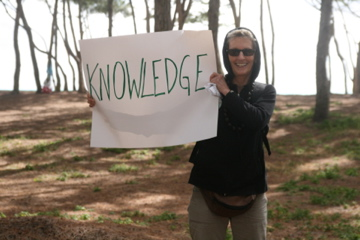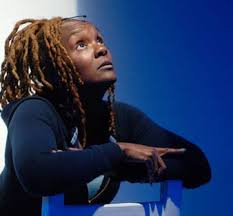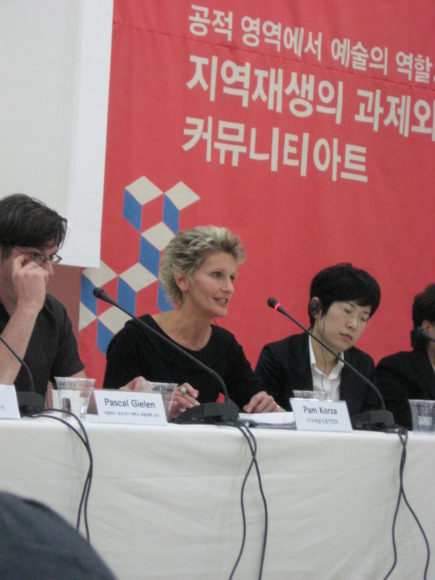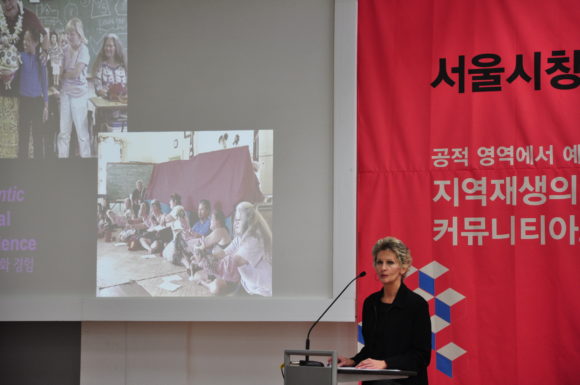I think of that “why?” question. For artists who are really serious about doing this kind of change based work, many of them come to it with a kind of moral imperative. And the folks that you probably intersect with most as activist artists really see it that way. It’s all about the change. And so, it’s like if you can’t figure out whether you are moving the needle at all, or contributing in some meaningful way, then why do it to begin with?
Pam Korza is the co-director Animating Democracy, a program of Americans for the Arts that connects arts and culture to community-building and social change efforts. She has consulted and offered workshops and presentations on the principles and practices of arts and civic engagement for artists, cultural organizations, funders, and universities. She has co-written and co-edited several books, including Civic Dialogue, Arts & Culture: Findings from Animating Democracy, and the Arts & Civic Engagement Tool Kit.
Steve Duncombe: This is the 10th year of the Center for Artistic Activism and in the back of my brain, I’ve always had the question: but does it actually really work? I’ve read a fair amount of stuff from theorists, and they’re super smart and really interesting and all, but I’m more interested in how practitioners, people like you and the artists themselves, address these questions.
In any case, I’d love to start out with just a personal question: How did you get into all of this?
Pam Korza: Well, if you trace back where I originated in my career, it was with the Arts Extension Service at the University of Massachusetts, and that organization in the early years, which was in the 70’s, was looking at the role of arts in community development. Mostly regionally , but soon AES became a national organization. In the context of that work, community development was the holy grail or the end point. It was important even then to say what are we aiming for and we are getting there. So evaluation was maybe more subliminal than explicit, but it became a part of how we looked at the world.
So, fast forward to the Animating Democracy work, which is decades later. The investigation in the early years of Animating Democracy was: What does this intersection of arts and civic dialog look like? And, if we’re really aiming to shift the way dialog happens in communities, what does that look like and how do we know if it’s happening?
There was evaluation built into the grant making that we were doing in our early 2000s with Ford Foundation resources, and we encouraged the grantees, with the help of coaches, to look from different angles at what difference their projects were making. Maybe they would choose to look at the artistic investigation and how that’s influenced by civic and social intention; maybe it was looking at the community or audience response to the work; maybe it was looking at the contribution to some sort of change in the community.
We gave them different lenses to choose from and so that was it. And then in 2007, as part of a civic engagement cohort that the Kellogg Foundation assembled, we got an unconditional grant and chose to take up the question: How do we evaluate this arts and civic engagement work?
And that sort of launched us seriously into the evaluation work, but really trying to get at some DIY ways that artists and cultural organization folks and their partners could do evaluation that was manageable and meaningful for them. Because just getting the work done is about all everybody can manage, evaluation is not a thing that most people will choose to put resources to or time toward.
SD: Well let’s talk about that. Are there other reasons — besides where one devotes their resources — which contributes to this resistance to assessment amongst artists?
PK: I think there is a reality of resistance to assessment. And some of it is grounded in the connotation of judgment that evaluation carries with it. And that, I think, is related to what people think of as quantifying evidence, you know, and empirical approaches that many think are ill suited to art, ill suited to art and social change.
There’s also a perception — among some, but not everybody — that evaluation is just not possible. We had a conversation amongst a bunch of evaluators in LA a few years ago, and two of them actually brought up this phenomenon of exceptionalism that they encounter a lot with some arts folks, that we’re exceptional. Like: “We can’t be quantified. We can’t be assessed in the same way that other things are.” There’s also a nagging fear that we’ll find out that we aren’t making a difference, or to the degree that we hope we are.
Maria Rosario Jackson, an urban planner who looks at value propositions around the arts and arts impact, has observed that, amongst different fields, the arts, are highly aspirational. We often set unrealistic expectations based on what a project or initiative can actually achieve. So we’re setting ourselves up for failure, in a sense, by doing that. What’s actually needed is to set outcomes that you can actually achieve, given the nature of the creative project.
SD: So for you, evaluation isn’t something that comes at the end, necessarily. It’s actually also something which is part of the planning of the project. So to set the aspirations and so on.
PK: Absolutely.

Pictured: Pam Korza
SD: Let’s go back to the fear of numbers and the immediate assumption I come across this all the time when I talk to artists or art-affiliated folks. They say: “Well, you can’t count these things,” when I’ve never brought up anything that’s quantitative. It’s just assumed that if I am talking about assessment it must mean numbers. But I’ve noticed that the sort of assessment tools that you’re proposing are not quantitative at all.
PK: Right.
SD: So, can you talk a little bit about non-quantitative approaches to assessment?
PK: Well, you know, there’s a lot about art that is subjective, qualitative, and not quantifiable. And the effects of art are the same sort of thing. So, looking at those effects means actually paying attention to social, emotional, educational or learning kinds of outcomes. We, Animating Democracy and some evaluators, devised a Continuum of Impact that defines six families of those kinds of outcomes: Changes in knowledge or awareness, changes in attitudes, changes in discourse. How people speak to each other. The nature of what’s discussed. Who’s coming to those conversations. Changes in capacity to engage in civic life or public life. Changes in behavior in action. Changes in conditions, equity systems, and structures.
The beautiful thing is, all of those things are are qualitative in nature, but can be quantified if you take a methodical approach to collecting that qualitative evidence.
There’s just a gap of knowledge that folks have about what can be quantified. So, that’s been some of the work we did with the Kellogg resource, together a field lab of evaluators, artists, and funders. And we created little teams, four or five teams of evaluators and artists who work together, not necessarily to evaluate a project, although a couple of them did, but to think together about what it is those artists really wanted to be looking at. And then how in the future they could actually describe and quantify some of the more qualitative evidence of change that their projects promoted.
I think that’s a significant shift in the way that a lot of people are looking at the arts’ role and potential to contribute to change. To look at story, to look at the six families of types of outcomes, and to map and potentially quantify change.
SD: Right. Well let’s ask the big question: Why bother with assessment at all? Why not just go out and do it, and you know let the magic of art take its course?
PK: Well, the magic of art is a reality, but you can’t really just say that to the many powers that be that are able to resource the work or include artists in sectors or contexts they can make a true difference. Somebody needs to understand: Well, how does that work? And does it work?
I think of that “why?” question. For artists who are really serious about doing this kind of change based work, many of them come to it with a kind of moral imperative. And the folks that you probably intersect with most as activist artists really see it that way. It’s all about the change.
And so, it’s like if you can’t figure out whether you are moving the needle at all, or contributing in some meaningful way, then why do it to begin with? Or are you being responsible and accountable if you’re not somehow trying to track .
SD: Can you talk about that? This idea of being responsible and accountable.
PK: Right now Animating Democracy is partnering with A Blade of Grass to create a guide for artists and municipal governments about how artists can play a role in government systems. The moment you start intersecting with other spheres that also have civic or social or justice-oriented goals, then it’s not all just your own little project. There’s a bigger frame around it, and a particular interest that those other partners have in the kind of change they want to see. You’ve got to be accountable in those kinds of relationships because there’s stuff at stake. And you can make mistakes. You can do harm. And you can also have really positive impact that, if you aren’t tracking it and figuring out that value-add of art, then people won’t believe that it can be a value-add.

Pictured: Rha Goddess in a performance of “Low”
SD: But let’s flip this question on its head, which is not about why we should assess art and actually see if it is creating social change, but instead the question of: “I’m interested in social change, why should I care about art? I mean, what is art actually bring in terms of value to the social change projects?”
PK: Sometimes I can think about these questions in relation to specific examples, and so when we were doing the Kellogg initiative, we connected with Rha Goddess. She is a hip hop artist, and at the time was based in New York. She did a project called Low, which was a one person performance about issues of mental health and stigma, and the health care system, particularly in the African American community and how it’s impacted by mental health and lack of services, stigma.
And so, as part of the lab, she worked with two different evaluators. A researcher at City University of New York and Suzanne Callahan, an evaluator who’s worked more in the arts. Rha had two different evaluations happening around her work because she was really trying to understand how her aesthetic choices were affecting people emotionally when they saw the performance, and in turn how that emotional response might influence them to think differently about what mental illness is, and that was addressing the stigma question. And how people who saw her show and participated in dialogues around it might actually take action differently in their personal lives in relation to perhaps people that they know, or whatever. But also how the arts could have value in the work of mental health workers. And so, those investigations were part of her evaluation work. The mental health workers that connected to her project commented that the treatment of using a provocative work of art coupled with dialogue, which was a part of her whole structure after the performance, worked better than counseling in getting people to disclose their issues and pain related to mental illness.
I think, you know, that notion of being able to demonstrate and give evidence of the value-add of art, compared to not, is an important part of the argument if you’re really trying to work across sectors, which many artists are interested in doing. Or if you’re an activist artist who’s trying to say there’s a role for art in movement building.
SD: Definitely. But let’s abstract that a little bit. This is something you’ve spent years working on. You could’ve done evaluation of so many different things in your life. Why art? What do you think that art can do?
PK: Well, you know, I think there’s a range of unique capacities that art brings, that other things probably don’t. You’ve heard people talk about opening hearts as well as minds. So there’s the emotional dimension of art — that art is very effective at engaging people in a place that’s beyond the cerebral and really gets internal to personal connection to issues, understanding the human implications of issues, and that using things, whether it’s story, metaphor, non-verbal ways of engaging with an idea or an issue. Those are all alternatives that are unique to art and that art brings.
I think art can create a way of engaging people to participate, whether it’s because it’s opening up a kind of different space that’s more attractive and maybe even fun. Or it’s creating a sort of safe zone for exploring complicated or emotional things. And it can also be a form of expression that involves people in bringing forward their own thoughts and ideas, emotionally connected to an issue.
 Pictured: Pam Korza
Pictured: Pam Korza
SD: I’m going to play devil’s advocate: You know, politics is really just about power. It’s really just about taking power from someone, passing laws, getting politicians elected. And art, you know, it’s really as you’re explaining, it’s just about sort of emotions and confidence. So what’s the use?
PK: I don’t like this question.
SD: I don’t like it either. That’s why I’m playing devil’s advocate.
PK: So, I think part of it is just a lack of understanding and education about the fact that art is a discipline. It’s a profession and a discipline like engineering or anything else. And that artists are critical thinkers and have ways of doing things that are sequential and build on theory, as well as their own experience. I might be skirting the question.
SD: No, no, I like that. Now I’m going to play the other side: Isn’t all this talk of art doing this or doing that, just instrumentalizing art? And aren’t people like you and I who are trying to think seriously about evaluation and what art can do, aren’t we just crushing the life out of this beautiful thing?
PK: I don’t think so. I mean, I think the beautiful thing should have as many values and applications in our world, and society, as possible. I think that there is absolutely still room and space for the true just pure joy and appreciation of creative expression. But we are talking about art that has intention to contribute to civic or social change, then it’s a different animal. You’ve got to begin to think about change means you’re working toward a different kind of end, and so you have to think about what is it in service to.
Now, the Aesthetic Perspectives framework that we introduced last year, in some regards, was a flip side to the Continuum of Impact that I mentioned earlier, in that as arts folks began to say to themselves: “We don’t really know how to evaluate the civic or social contributions we’re making,” they to some extent we were losing sight of: What about the creative work itself? What about the aesthetics of it is strong? And how are those artistic choices advancing the civic or social intent of the work? So, the aesthetic framework was really a response to the aesthetic excellence of that work.
Artists were really the instigators of this framework. They were saying: “You know there is such a thing as mediocre or poor arts-for-change work, and we do believe there are standards of excellence for this work, so let’s start framing what we think those qualities are in excellent arts-for-change work.” They were seeing that the work was being viewed as social work or instrumentalized, perhaps too much, and not being seen as art. So how do we elevate the aesthetics as essential to effective work? They were seeing that the creative process is often huge, and maybe sometimes even more important than final product wasn’t being recognized as a dimension of the work — or it was being misunderstood or underappreciated. So, the framework was a way to ensure that that aspect of the work was being looked at, as well.
And then finally, and importantly, a Euro-centric aesthetic paradigm has been in operation for since we can remember, in terms of assessing the aesthetic aspects of work, within funding panels, by critics, etc. But there’s a whole other range of cultural and artistic practice to look at, whether it’s traditional folk arts or hip-hop or pop culture. We have to be sure that we’re being fair in how we’re looking at the work.
So, the aesthetics framework was, like, let’s make sure we’re not diminishing the potency of the art in arts for change, because if the art is impotent, then it’s not going to be as effective as it could be.





You must be logged in to post a comment.